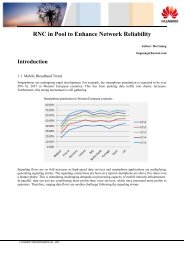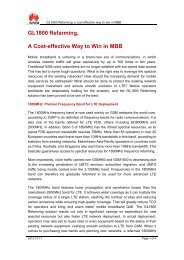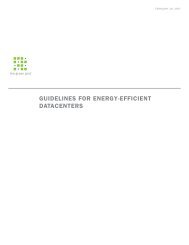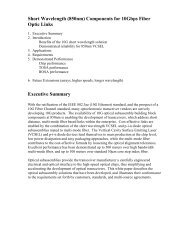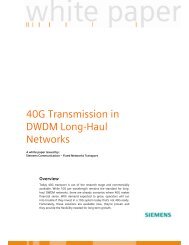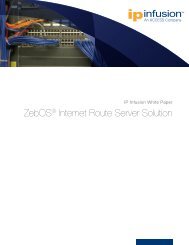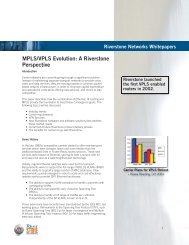NEXT GENERATION ACCESS - Light Reading
NEXT GENERATION ACCESS - Light Reading
NEXT GENERATION ACCESS - Light Reading
Create successful ePaper yourself
Turn your PDF publications into a flip-book with our unique Google optimized e-Paper software.
WHITE PAPER<br />
Iskratel FTTx White Paper<br />
<strong>NEXT</strong> <strong>GENERATION</strong> <strong>ACCESS</strong><br />
FTTC and FTTB Broadband Access Combinations<br />
Uroš Jenko<br />
September 2009<br />
Obr.:70-159c<br />
MAD085100-GLE-010
Content<br />
1 Why combine access technologies? .............................................................................................. 2<br />
1.1 Current and future requirements for broadband subscriber access ................................................... 2<br />
2 Why decide for FTTx? ...................................................................................................................... 3<br />
2.1 Improve your market position faster ................................................................................................... 3<br />
2.2 Optimal for existing copper infrastructure owners .............................................................................. 3<br />
2.3 Lower deployment costs ..................................................................................................................... 4<br />
3 Network Access deployment scenarios ......................................................................................... 4<br />
3.1 Fiber-to-the-Curb Scenarios ............................................................................................................... 5<br />
3.1.1 FTTC with VDSL2 .................................................................................................................. 5<br />
3.1.2 FTTC with ADSL2+ ................................................................................................................ 7<br />
3.1.3 FTTC with POTS ................................................................................................................... 8<br />
3.1.4 Required network elements ................................................................................................... 9<br />
3.1.5 FTTC with Combo Access ..................................................................................................... 9<br />
3.2 Fiber-to-the-Building Scenarios ........................................................................................................ 10<br />
3.2.1 FTTB with VDSL2 ................................................................................................................ 10<br />
3.2.2 FTTB with ADSL2+ .............................................................................................................. 12<br />
3.2.3 FTTB with POTS.................................................................................................................. 13<br />
3.2.4 FTTB with Ethernet .............................................................................................................. 13<br />
4 Shelters ............................................................................................................................................ 15<br />
Obr.:70-159c<br />
4.1.1 ODU-M Outdoor Shelter for FTTC Solutions ....................................................................... 15<br />
4.1.2 FTTC ODU-S Small Outdoor Shelter for FTTC Solutions ................................................... 16<br />
4.1.3 IDU-M Indoor Cabinet for FTTB Solutions .......................................................................... 16<br />
5 Power Supply .................................................................................................................................. 17<br />
5.1 Remote Power Supply (RPS) ........................................................................................................... 18<br />
5.1.1 RPS Characteristics ............................................................................................................ 18<br />
6 Home networking ............................................................................................................................ 19<br />
6.1 The home-gateway family members ................................................................................................. 19<br />
6.1.1 VDSL2 Home Gateway: Proteus932+ ................................................................................. 19<br />
6.1.2 ADSL2+ Home Gateway: Sinope568+ ................................................................................ 20<br />
6.1.3 Ethernet Home Gateway: Loona132 ................................................................................... 20<br />
MAD085100-GLE-010<br />
1
1 Why combine access technologies?<br />
All-fiber access networks are becoming a reality, and the penetration ratio of all-fiber-based networkaccess<br />
versions is growing rapidly. Although the all-fiber access (FTTH) network serves as the ultimate<br />
goal, many existing last-mile copper-based connections still have unused potential.<br />
At the end of this paper, you will understand that combining fiber connections with last-few-meters copper<br />
wiring in many cases represents the most economical method for fiber-access deployment. The hybrid<br />
fiber-copper access FTTx scenario is an answer to the ever-increasing demand for rational and costsaving<br />
existing network deployments and upgrades.<br />
A narrow definition of FTTx includes two different hybrid fiber-access types: Fiber-to-the-Curb and Fiberto-the-Building.<br />
In addition to these two options, this paper covers all the options that are to be found in<br />
the world of fiber-related subscriber network access.<br />
1.1 Current and future requirements for broadband subscriber<br />
access<br />
To serve the increasing bandwidth demand has become a mantra for every service provider and<br />
infrastructure owner over the past decade. Since the use of video, including TV streaming, VoD, NPVR<br />
and other demanding services, has become widely accessible, every operator and service provider faces<br />
the difficult task of maintaining the right balance between necessary infrastructural investments and the<br />
level to which the access network’s capacities are exploited.<br />
The fact that entirely copper-based network access is slowly becoming a mostly inadequate access<br />
solution for more than basic users is already widely accepted. Nielsen's Law of Internet Bandwidth tells<br />
us that high-end users’ bandwidth need grows by a staggering 50% per year.<br />
Within a few years, the demanding services that are becoming a necessary part of an operator’s offer, are<br />
pushing the bandwidth standard toward the 100 Mb/s benchmark. The various forms of DSL access<br />
technologies no longer cope with such demands.<br />
2 MAD085100-GLE-010 Obr.:70-159c
Why 100Mb/s as a benchmark? Multiple HDTV sets in a single home is soon going to become a reality. A<br />
growing share of users falls into the heavy web-user category. This means video blogging, YouTube<br />
addiction, and 24/7 content down- and uploading.<br />
End users demand the highest possible quality. It is time for the next-generation access network.<br />
2 Why decide for FTTx?<br />
If an operator is facing a dilemma as to whether or not to build an entirely new FTTH subscriber access<br />
infrastructure or to upgrade the infrastructure using the combined fiber-copper FTTx solutions, here are<br />
the four major answers to the dilemma. In short, the deployment of FTTx-oriented access solution results<br />
in a quickly gained competitive advantage over competitive wireline and wireless network operators, the<br />
optimal re-use of the existing copper infrastructure, a decreased capital expenditure and an improved<br />
return on investment ratio.<br />
General FTTx pros:<br />
• Reduced demand for all-fiber connections – lower CAPEX,<br />
• Less digging and in-house wiring interventions,<br />
• Faster deployment of the high bandwidth service offer,<br />
• 24-hour life-line support.<br />
2.1 Improve your market position faster<br />
Every network operator is aware that every week counts when struggling for the subscriber base in a<br />
highly competitive market. Basically, there are two ways of retaining the current number of subscribers:<br />
• by keeping the monthly bill lower than the competition,<br />
• by offering a better service quality.<br />
Keeping the monthly bill as low as possible may not be an optimal solution, especially over the long term.<br />
Indeed, it is the quality and end-user satisfaction that are going to ensure long-term profitability. And this<br />
is what FTTx is all about. It quickly upgrades the existing copper access infrastructure with high-end<br />
capabilities without the need for additional, expensive cable dig-ups in the last mile. It is a well-known fact<br />
that the last 100 meters of cable are the most expensive and that they require lots of time to be laid.<br />
2.2 Optimal for existing copper infrastructure owners<br />
If it is there, why not use it? Past deployments and recently 1 unveiled global plans and FTTx-based<br />
network access deployments prove that copper connections are going to represent a very significant<br />
share of the end-user connections for the next couple of decades. FTTx boosts the unused potential of<br />
1<br />
Countries with notable installations are Japan, Korea, the Netherlands, Sweden, and the USA. In some countries<br />
FTTx constitutes the fastest-growing type of broadband access.<br />
Obr.:70-159c<br />
MAD085100-GLE-010<br />
3
the copper access network and turns it into a highly capable and future-proof access solution for<br />
residents and SOHO business users.<br />
The global trend in existing network upgrading shows that operators have three main goals:<br />
• To offer a broadband service to a new area (where the current infrastructure is inadequate);<br />
• To upgrade the existing broadband service to higher speeds and to offer IPTV, VoD, HD and<br />
other services;<br />
• To avoid decreasing the quality of the broadband service where DSL penetration is high<br />
(interference issues).<br />
2.3 Lower deployment costs<br />
FTTx is a cost-optimized network-access solution for existing network upgrades. FTTx has been proved<br />
to result in much lower fixed and variable costs in comparison with other access network deployment<br />
options with similar capabilities.<br />
Source: Analysis Mason for British Telecom 2<br />
3 Network Access deployment scenarios<br />
FTTx represents a versatile and flexible approach to constructing the network’s last mile. It generally<br />
includes Fiber-to-the-Curb (FTTC) and Fiber-to-the-Building (FTTB) architectures with multiple<br />
deployment scenarios.<br />
Iskratel has shaped the following typical hybrid fiber-copper access solutions, suitable for every technical<br />
or economical requirement listed under the fiber-to-the-curb or fiber-to-the-building scenarios:<br />
1. FTTC<br />
• FTTC with VDSL2 for existing residential and business subscriber connection upgrades<br />
with large network capacity requirements.<br />
• FTTC with ADSL2+ for existing residential subscriber connection upgrades.<br />
2<br />
The deployment costs for different access technologies depend on the regional specifics. The differences may be<br />
smaller in areas with a higher population density.<br />
4 MAD085100-GLE-010 Obr.:70-159c
Obr.:70-159c<br />
2. FTTB<br />
• FTTC with POTS for the migration of legacy POTS subscribers to VoIP-controlled<br />
networks.<br />
• FTTC with Combo Access (POTS and ADSL2+) for future-ready upgradable voice or<br />
DSL connections.<br />
• FTTB with VDSL2 for very-high-capacity subscriber connections in existing multi-tenant<br />
buildings.<br />
• FTTB with ADSL2+ for existing in-building residential subscriber connection upgrades.<br />
• FTTB with POTS for the migration of legacy POTS subscribers to IP-controlled networks.<br />
• FTTB with Combo Access for future-ready upgradable voice-connection upgrades.<br />
• FTTB with Ethernet (ETTH) combined with Ethernet for new multi-tenant buildings with<br />
UTP wiring.<br />
CO<br />
3.1 Fiber-to-the-Curb Scenarios<br />
3.1.1 FTTC with VDSL2<br />
FTTC<br />
FTTB<br />
street cabinet<br />
Fiber and copper-access technologies are not as competitive as it might seem. They work hand in hand<br />
when providing a high-capacity and cost-optimized residential or business subscriber access. The hybrid<br />
access combination of Fiber-to-the-Curb and VDSL2 is an excellent option for service provisioning over<br />
existing copper lines from a nearby street cabinet (Iskratel ODU-M or ODU-S shelters).<br />
Typically, the FTTC solution combined with VDSL2 subscriber access allows data-transmission speeds<br />
up to approximately 100Mbit/s (distances up to 1 km) for a single end-user connection. Such a capacity<br />
makes the access option suitable for a complete Triple-Play service offer on the existing last-mile wiring.<br />
MAD085100-GLE-010<br />
VDSL2 ~ 100/50 Mb/s per user<br />
ADSL2+ ~ 24/1 Mb/s per user<br />
POTS<br />
MTU<br />
residential<br />
area<br />
Ethernet or VDSL2<br />
up to 100/100 Mb/s<br />
per user<br />
5
FTTC with VDSL2 pros:<br />
• Reuse of the existing copper wiring,<br />
• Enhanced performance over shorter line distances (up to 1 km).<br />
3.1.1.1 Typical use<br />
The FTTC+VDSL2 option serves as an optimal access solution for residential and SOHO business users<br />
that require high bandwidth and are already connected via existing copper lines to the narrowband<br />
network (POTS or ISDN). Using the hybrid access solution, the existing narrowband network is upgraded<br />
to high-capacity data links, while the POTS itself may be upgraded to an IP-based connection (see<br />
Section 3.1.3).<br />
The subscribers are connected to the SI3000 MSAN access node, which is located at a nearby street<br />
cabinet (at distances normally shorter than 1 kilometer). The access node in the outdoor shelter is<br />
equipped with Iskratel VDSL2 subscriber blades and uses a fiber uplink to the network operator’s central<br />
office. Iskratel also offers smaller ODU-S cabinets that are intended to cover smaller subscriber areas.<br />
The local loop in this case is less than 1 kilometer long. On such short distances, the maximum<br />
transmission speeds reach 100 Mb/s downstream with 50 Mb/s upstream. The shorter distance between<br />
the shelter and the subscriber also requires less bandwidth delivered to the shelter.<br />
3.1.1.2 Required network elements<br />
Central office<br />
SI3000 MSAN with Giga Fiber blade<br />
Remote cabinet<br />
SI3000 MSAN with VDSL2 blade<br />
ODU-M shelter (SI3000 MSAN in MEA 20 packaging)<br />
ODU-S shelter (SI3000 MSAN in MEA 10 packaging)<br />
Power Supply<br />
MPS 1000.50 for ODU-M shelter<br />
MPS 1000.25 for ODU-S shelter<br />
RPS<br />
FTTCurb<br />
VDSL2<br />
~50 Mbit/s<br />
Central office Remote cabinet<br />
Users<br />
SOHO<br />
business<br />
users<br />
Residential<br />
users<br />
6 MAD085100-GLE-010 Obr.:70-159c
Users<br />
Proteus VDSL2 home gateway<br />
3.1.2 FTTC with ADSL2+<br />
Compared to the previously described FTTC with the VDSL2 deployment option, the FTTC with ADSL2+<br />
ensures broadband connectivity over larger distances. Using the ADSL2+ access technology an operator<br />
connects the subscribers at distances of up to five kilometers and still provides them on shorter distances<br />
with up to 20 Mb/s of downstream data-transmission speed.<br />
FTTC with ADSL2+ pros:<br />
• Broadband evolution: the “natural” option for a dial-up upgrade,<br />
• The reliable option in cases of questionable quality of the copper wiring,<br />
• Mature, standardized, fully interoperable, and low-cost technology.<br />
3.1.2.1 Typical use<br />
Fast broadband access deployment in urban, suburban and rural areas. FTTC with ADSL2+ is especially<br />
suitable for areas with more dispersed subscribers (better downstream performance over longer<br />
distances compared to VDSL2).<br />
The Iskratel SI3000 MSAN access node equipped with ADSL2+ blades enables the streaming of multiple<br />
high-definition channels on a single subscriber port. In other words, the ADSL2+ blade allows at least two<br />
high-definition TV channels on a single DSL port for every subscriber connected to the same blade. All<br />
the necessary QoS and security parameters are guaranteed.<br />
3.1.2.2 Required network elements<br />
Central office<br />
SI3000 MSAN with Giga Fiber blade<br />
Remote cabinet<br />
SI3000 MSAN with ADSL2+ blades<br />
Obr.:70-159c<br />
FTTCurb<br />
Central office Remote cabinet<br />
Users<br />
MAD085100-GLE-010<br />
ADSL2+<br />
~20 Mbit/s<br />
SOHO<br />
business<br />
users<br />
Residential<br />
users<br />
7
ODU-M shelter (SI3000 MSAN in MEA 20 packaging)<br />
ODU-S shelter (SI3000 MSAN in MEA 10 or smaller packaging)<br />
Power Supply<br />
MPS 1000.50 for ODU-M shelter<br />
MPS 1000.25 for ODU-S shelter<br />
RPS<br />
Users<br />
Sinope ADSL2+ home gateway<br />
3.1.3 FTTC with POTS<br />
Voice telephony still remains an important user-connection type. There are three typical situations in<br />
which the network operators should decide for the FTTC+POTS deployment.<br />
1. To deploy the FTTC+POTS solution serves as a means of PSTN subscriber migration. It helps<br />
modernize the network infrastructure elements with IP connectivity after the completed life span<br />
of the TDM technology in a very economical manner.<br />
2. Many network operators still have a significant share of subscribers that do not want to switch to<br />
broadband access technologies. In such a scenario, the FTTC+POTS solution, controlled by the<br />
Iskratel SI3000 CS softswitch, serves as a TDM network substitute.<br />
3. The POTS line still presents the most economical way to ensure a lifeline-enabled subscriber<br />
connection with a 24-hour battery backup reserve provided in the shelter and no significant<br />
worries about the battery exchange as in the case of VoIP over broadband access.<br />
3.1.3.1 Typical use<br />
The FTTC+POTS option is the most appropriate IP-based access solution when at least one of the<br />
residential voice subscribers wants to retain an existing POTS connection and analog phone sets. By<br />
deploying the FTTC+POTS access solution, the network operator solves the problem of the necessary<br />
maintenance of the old TDM exchange.<br />
The subscribers are connected to the SI3000 MSAN access node, which is located at a nearby street<br />
cabinet. The access node in the outdoor shelter is equipped with Iskratel POTS subscriber blades and<br />
uses an Ethernet fiber uplink to the network operator’s central office.<br />
8 MAD085100-GLE-010 Obr.:70-159c
Selective Power Control (SPC TM )<br />
3.1.4 Required network elements<br />
Central office<br />
SI3000 MSAN with Giga Fiber blade<br />
Remote cabinet<br />
SI3000 MSAN with POTS blades<br />
ODU-M shelter (SI3000 MSAN in MEA 20 packaging)<br />
ODU-S shelter (SI3000 MSAN in MEA 10 or smaller packaging)<br />
Power Supply<br />
MPS 1000.50 for ODU-M shelter<br />
MPS 1000.25 for ODU-S shelter<br />
RPS<br />
Obr.:70-159c<br />
FTTCurb<br />
Central location Remote cabinet<br />
Using the Selective Power Control (SPCTM) function, a 24-hour life-line support<br />
is provided with minimal battery and power-supply costs. If an electrical blackout<br />
happens, the batteries power only the narrowband (voice telephony) interfaces.<br />
In such a case, the broadband ports or blades are shut down. By using this<br />
mechanism, the 24h life-line is provided in the most economical way.<br />
SPC TM benefits:<br />
• Lower costs of battery exchange,<br />
• Less required battery space: smaller shelter with less visual impact on<br />
the environment.<br />
3.1.5 FTTC with Combo Access<br />
Combo Access represents a combination of the POTS and ADSL2+ connection on a single subscriber<br />
board. The combined access is optimal in cases when the operator wishes to preserve the maximum<br />
flexibility of the subscriber access type. The basic POTS connection is quickly upgradeable with the high-<br />
MAD085100-GLE-010<br />
POTS<br />
Users<br />
Residential<br />
users<br />
9
capacity broadband ADSL2+ connection using a single administrative action and a single SI3000 MNS<br />
network management application.<br />
FTTC with Combo Access pros:<br />
• “The” choice for fast ADSL2+ broadband deployment;<br />
• Combo Access answers the regulatory demands for the POTS line in<br />
the case of broadband subscribers;<br />
• Subscription change without on-site administrative actions: lower<br />
OPEX.<br />
3.1.5.1 Typical use<br />
Combo Access represents a great advantage when the penetration of broadband subscribers in a certain<br />
region is going to rise quickly. By using the combined subscriber boards, the voice-telephony user is<br />
connected with a POTS/ADSL2+ connection from the start. Future switching to a pure broadband<br />
connection is therefore fast and, what matters the most, it does not represent any additional costs since<br />
all the subscribers are pre-wired with both access types.<br />
The Combo blade is equipped with combined ADSL2+/POTS ports and integrated splitters. The<br />
elimination of the outside splitters greatly simplifies the system complexity and reduces the amount of<br />
cabling needed.<br />
FTTCurb<br />
Central office Remote cabinet<br />
Users<br />
3.2 Fiber-to-the-Building Scenarios<br />
3.2.1 FTTB with VDSL2<br />
POTS/ADSL2+<br />
SOHO<br />
business<br />
users<br />
Residential<br />
users<br />
The high-speed VDSL2 connection allows an up to 100/100 Mb/s per subscriber connection over a short<br />
distance. Therefore, the achieved bandwidths within the building’s network are comparable to those of<br />
optical or UTP connections, while using the existing copper wiring.<br />
The combination of FTTB and VDSL2 access technology serves as a cost-optimized and time-efficient<br />
option for the introduction of demanding Triple-Play services, gaming, teleconferencing and VPN access.<br />
10 MAD085100-GLE-010 Obr.:70-159c
FTTB with VDSL2 pros:<br />
• High quality and short copper pairs with no cross-talks allow the use of<br />
higher VDSL2 profiles (30a with 100Mb/s up- and downstream and<br />
17a with 100Mb/s downstream and 50 Mb/s upstream).<br />
• Appropriate for existing infrastructure upgrades.<br />
3.2.1.1 Typical use<br />
The FTTB with the VDSL2 hybrid access solution connects the subscribers in multi-tenant buildings using<br />
the SI3000 MSAN VDSL2 blade. The in-building access node is placed inside the compact Iskratel IDU-M<br />
indoor shelter.<br />
The in-building SI3000 MSAN transforms the existing wiring that was previously used as a voice-only or<br />
low-speed broadband connection into broadband-enabled user connections that are terminated by the<br />
Iskratel Proteus VDSL2 home gateway.<br />
3.2.1.2 Required network elements<br />
Central office<br />
SI3000 MSAN with Giga Fiber blade<br />
Remote cabinet<br />
SI3000 MSAN platform with VDSL2 blades<br />
IDU-M shelter (SI3000 MSAN in MEA 10 or smaller packaging)<br />
Users<br />
Proteus VDSL2 home gateway<br />
Power Supply<br />
MPS 1000.25<br />
RPS<br />
Obr.:70-159c<br />
Central location<br />
Users<br />
FTTBuilding<br />
MAD085100-GLE-010<br />
VDSL2<br />
~100 Mb/s<br />
11
3.2.2 FTTB with ADSL2+<br />
Using ADSL2+ inside a multi-tenant building is an alternative option to the VDSL2 access technology.<br />
Despite allowing less bandwidth, the ADSL2+ connection’s advantage is robustness, high interoperability<br />
and, in many cases, an optimal price/performance ratio.<br />
The ADSL2+ connections over the existing in-house wiring represent a highly capable Triple-Playenabled<br />
communications infrastructure.<br />
FTTB with ADSL2+ pros:<br />
• Convenient for buildings with average quality wiring.<br />
• Price optimized for areas with bandwidth demand up to 24 Mb/s.<br />
3.2.2.1 Typical use<br />
The FTTB with ADSL2+ access solution connects the subscribers in multi-tenant buildings using a<br />
SI3000 SI3000 MSAN with ADSL2+ blades. The in-building access node is placed inside the compact<br />
Iskratel IDU-M indoor shelter.<br />
In the case of FTTB with ADSL2+, the in-building SI3000 MSAN transforms the existing wiring into<br />
broadband-enabled subscriber connections that are terminated by the Iskratel Sinope ADSL2+ home<br />
gateways.<br />
Central location<br />
3.2.2.2 Required network elements<br />
Central office<br />
SI3000 MSAN with Giga Fiber blade<br />
Users<br />
FTTBuilding<br />
Remote cabinet<br />
SI3000 MSAN platform with ADSL2+ blades<br />
IDU-M shelter (SI3000 MSAN in MEA 10 or smaller packaging)<br />
ADSL2+<br />
~20 Mb/s<br />
12 MAD085100-GLE-010 Obr.:70-159c
Users<br />
Sinope home gateway<br />
Power Supply<br />
MPS 1000.25<br />
RPS<br />
3.2.3 FTTB with POTS<br />
Voice telephony still remains an important user-connection type. There are three typical situations in<br />
which the network operators should chose an FTTB+POTS deployment (see Section 3.1.3 for a more<br />
detailed explanation):<br />
• PSTN migration,<br />
• a significant share of voice-only subscribers,<br />
• life-line support.<br />
FTTB with POTS pros:<br />
• The ability to deploy the proprietary POTS voice lines in countries<br />
where apartment owners are also wired infrastructure owners.<br />
• Ideal for newly built buildings with in-house exchange systems.<br />
• Less power needed for analog phone powering.<br />
3.2.3.1 Typical use<br />
Obr.:70-159c<br />
Central location<br />
Users<br />
FTTBuilding<br />
3.2.4 FTTB with Ethernet 3<br />
When compared to DSL technologies, the copper Ethernet’s position serves as a competitive option with<br />
significant advantages in environments where the access loop’s length does not exceed 100 meters. In<br />
3 Also known as ETTH or Metro Ethernet.<br />
POTS<br />
MAD085100-GLE-010<br />
13
uildings with common UTP wiring, the FTTB+Ethernet access solution represents a cost-effective, easyto-deploy<br />
technology for service providers in multi-tenant buildings and enterprise campus environments<br />
with broadband access.<br />
FTTB with Ethernet pros:<br />
• Ideal for buildings with existing UTP wiring or easy-to-deploy UTP wiring;<br />
• 1U switch enables a lower-price access solution compared to other BB<br />
access options;<br />
• No CPE required in the case of pure internet access.<br />
3.2.4.1 Typical use<br />
The FTTB+Ethernet access solution connects the subscribers in multi-tenant buildings using the Iskratel<br />
1U Ethernet switches and the in-building SI3000 MSAN access nodes that act as an aggregation switch.<br />
A building is equipped with single SI3000 MSAN access nodes and, when the number of inhabitants is<br />
larger, multiple 1U switches nodes located on each floor or at each entrance. The maximum length of the<br />
UTP cable between the 1U switch and the apartment doors is, in practice, 70 m.<br />
Central location<br />
3.2.4.2 Required network elements<br />
Central office<br />
SI3000 MSAN with Giga Fiber Blade<br />
FTTBuilding<br />
Users<br />
Remote cabinet<br />
IDU-M shelter (SI3000 MSAN in MEA 10 or smaller packaging)<br />
Floor, entrance or wall-mounted shelter<br />
Iskratel 1U Ethernet switch<br />
Ethernet<br />
~100 Mb/s<br />
14 MAD085100-GLE-010 Obr.:70-159c
Users<br />
Loona home gateway or Gemini residential switch<br />
4 Shelters<br />
Shelters for the Iskratel remotely deployed FTTx networking equipment are available as a completely preequipped<br />
and pre-tested plug-and-play solution. Both the outdoor shelters and indoor cabinets are<br />
equipped with a complete telecommunications infrastructure (active equipment, power supply, batteries,<br />
cables, distribution frame) needed for the carrier-grade Telco environment.<br />
Outdoor shelters (ODU-M and ODU-S) can operate in practically any environmental conditions. They are<br />
equipped with a heat exchanger and an air-conditioning system and are therefore designed for outdoor<br />
use with a temperature range from -50°C up to +50°C. The IDU-M indoor shelter is designed for operating<br />
in a weather-protected environment with a temperature range from -5 to +45°C.<br />
Shelter installation requires minimum effort and expense due to the plug-and-play concept of the Next-<br />
Generation Access solution. All that is needed is to connect the power cables, the optical uplink cable and<br />
the subscribers’ copper pairs.<br />
4.1.1 ODU-M Outdoor Shelter for FTTC Solutions<br />
The Iskratel ODU-M outdoor shelter is designed for larger-scale FTTC access solutions in rural, suburban<br />
and urban networks. The shelter brings the entire fiber-based user connection closer to the users in an<br />
economical way.<br />
The ODU-M fits with all the equipment required for undisturbed and autonomous operation. It excels in<br />
terms of:<br />
• wide operating-temperature range (-50°C to + 50°C),<br />
• low power consumption,<br />
• small mounting space,<br />
• maximized capacity,<br />
• easy maintenance.<br />
The size of the ODU M allows the deployment of a single SI3000 MSAN access node as a MEA 20<br />
package.<br />
A single ODU-M shelter has a capacity of up to 576 ADSL2+/VDSL2 lines with splitters or 1056 POTS<br />
lines.<br />
On-site intervention is very simple because all the equipment can be accessed from the front side. The<br />
distribution frame is in a separate compartment, accessed from the right-hand side.<br />
The outdoor shelter, ODU-M, also accommodates a battery-supported power-supply system MPS1000.50<br />
with up to 196 Ah of battery reserve. It includes an integrated distribution frame, a heat exchanger and<br />
elements for the protection and management of the system operation. All the system elements are<br />
managed from a central SI3000 management node.<br />
Obr.:70-159c<br />
MAD085100-GLE-010<br />
15
4.1.2 FTTC ODU-S Small Outdoor Shelter for FTTC Solutions<br />
In the cases of a more dispersed subscriber distribution, Iskratel recommends designing the FTTC<br />
access solution around the compact ODU-S outdoor shelter.<br />
The ODU-S shelter represents a very cost-optimized (half the prices of ODU-M) sheltering solution with<br />
only 45 cm of depth, full vandal resistance, a steel construction and 24-hour battery support for the POTS<br />
subscriber lines.<br />
The shelter is equipped with the Iskratel MPS1000.25 and remote powering RPS power supply. It offers<br />
enough volume for a single SI3000 MSAN access node in a MEA10 package.<br />
A fully equipped ODU-S shelter connects up to 128 VDSL2, 192 ADSL2+ or 576 POTS subscribers.<br />
4.1.3 IDU-M Indoor Cabinet for FTTB Solutions<br />
The IDU-M shelter is designed for cost-efficient FTTB solutions in suburban and urban networks. The<br />
main advantage of the IDU M is that it efficiently integrates all the equipment required for undisturbed and<br />
autonomous operation. The IDU-M excels in terms of its low power consumption, extremely small<br />
mounting space, maximized capacity and easy maintenance.<br />
On-site intervention is very simple because all the equipment can be accessed from the front side with<br />
separate access to the equipment and the distribution frame compartments. Built in lamps facilitate<br />
interventions in night-time conditions.<br />
16 MAD085100-GLE-010 Obr.:70-159c
The IDU M also accommodates a battery-supported modular power-supply system, an integrated<br />
distribution frame, an intelligent filter fan system and elements for protection. All the system elements are<br />
managed from a central management node.<br />
The shelter is equipped with the Iskratel MPS1000.25 and the remote powering RPS power supply with<br />
24h of battery reserve for the POTS subscriber lines.<br />
It offers enough volume for a single SI3000 MSAN access node in a MEA10 package.<br />
A fully equipped IDU-M shelter connects up to 216 VDSL2, 288 ADSL2+ or 576 POTS subscribers.<br />
5 Power Supply<br />
The shelters deployed in FTTC and FTTB access solutions are powered locally or remotely by the Iskratel<br />
Modular Power Supply (MPS) system. Local or remote powering options ensure an uninterrupted and<br />
centrally managed power supply for CO and remote access network elements.<br />
The benefits of using the Iskratel MPS power-supply system:<br />
• central management with SI3000 MNS network management system;<br />
• modular design;<br />
• high efficiency (>93%);<br />
• turn-key power-supply solution;<br />
• battery control and capacity measurement;<br />
• environmental control and reporting;<br />
• wide range of DC/DC and DC/AC current-converting options.<br />
The MPS 1000 is a modular power-supply system with capacities that can be adjusted to the power<br />
requirements of users, within the framework of predefined power capacities. Iskratel provides the market<br />
with a maximum-output power supply of 1500 A. Typical FTTC and FTTB access solutions include the<br />
MPS1000.50 or 1000.25 power-supply systems.<br />
Obr.:70-159c<br />
MAD085100-GLE-010<br />
17
Iskratel MPS options<br />
Save time and money with the Iskratel MPS power-supply systems<br />
Iskratel power-supply systems are equipped with the ARH controlling unit. The controlling unit is a<br />
standard MPS1000 element with IP connectivity that eases basic remote or local system<br />
adjustments, prolongs the lifespan of backup batteries and makes the system maintenance more<br />
effective. The ARH controlling unit additionally provides system performance tests and reports<br />
about ambient measurements and alarms. The latter may be user-defined according to current<br />
requirements.<br />
5.1 Remote Power Supply (RPS)<br />
The RPS remote-powering system is the cost-saving way of providing the power supply for remote<br />
networking equipment in various FTTC and FTTB scenarios. The system enables the reuse of copper<br />
links that were made obsolete by newer CO remote cabinet optical connections for the remote power<br />
feeding of access nodes.<br />
A single central part of the RPS system allows the use of up to 24 copper pairs with up to 100 W of power<br />
per single pair. The remote part includes up to four receiving modules with up to three copper pairs per<br />
single module. Each module receives 73 W of maximum power per single pair.<br />
To remotely power the access nodes in FTTC and FTTB solutions ensures an uninterrupted 24/7 power<br />
supply with full autonomy (central battery backup). RPS therefore makes the use of remote batteries<br />
obsolete. Additionally, all the environmental and legal issues with local powering, such as electrical<br />
counters, building-owner permissions and power-outlet installations, are solved.<br />
5.1.1 RPS Characteristics<br />
The RPS capacity depends on the loop length and the resistance. The table below shows the maximum<br />
distances at a given loop resistance and the transmitted power (in the case of a 100-W input power):<br />
18 MAD085100-GLE-010 Obr.:70-159c
Copper line<br />
diameter<br />
Obr.:70-159c<br />
Loop resistance<br />
[Ohm/km]<br />
Max. loop length at a certain diameter for a given loop<br />
resistance and line power<br />
600 Ohm<br />
(48.9 W)<br />
500 Ohm<br />
(53.7 W)<br />
MAD085100-GLE-010<br />
400 Ohm<br />
(58.5 W)<br />
300 Ohm<br />
(63.3 W)<br />
200 Ohm<br />
(68.1 W)<br />
100 Ohm<br />
(72.9 W)<br />
0.4 mm 139 4.3 km 3.6 km 700 m<br />
0.5 mm 89 6.7 km 4.5 km 1.1 km<br />
0.6 mm 62 9.6 km 4.8 km 1.6 km<br />
0.8 mm 35 17.1 km 5.7 km 2.8 km<br />
6 Home networking<br />
The family of Iskratel home gateways is easily customizable for every networking environment, operator<br />
type or ISP. Printed, custom-designed housings and an adapted web interface support the service<br />
providers’ business model.<br />
The entire range of Iskratel home gateways is intended for triple-play service delivery at the highest level.<br />
Subscribers experience the full extent of modern networking: real-time business communications and the<br />
most exciting entertainment or educational content.<br />
6.1 The home-gateway family members<br />
6.1.1 VDSL2 Home Gateway: Proteus932+<br />
The VDSL2 Home Gateway Proteus932+ combines a VDSL modem and a powerful home-networking<br />
engine in a single device. It enables service providers to offer connections of up to 100 Mb/s downstream,<br />
and more with the new VDSL2 technology. Furthermore, Proteus932+ enables a multiple profile<br />
arrangement to gain symmetrical or asymmetrical connections from the CO or remote-access module<br />
deployments and to provide the desired bandwidths even on longer subscriber loops.<br />
The VDSL2 Home Gateway Proteus932+ supports the delivery of all the triple-play services: internet<br />
data, Voice over IP (VoIP) and IP video, including bandwidth-consuming HDTV. For packet-based<br />
terminal devices it provides four Ethernet ports as well as a wireless access point 802.11g 4 .<br />
Benefits:<br />
• support for centralized TR-069 management of multiple home gateways,<br />
• 100 Mb/s routing performance,<br />
• powerful home-gateway engine for offering Triple-Play services on broadband connectivity,<br />
• service separation and prioritization with bandwidth reservation,<br />
• fully featured Router and Firewall, secure wireless transmitting and authentication.<br />
4 Available with WiFi USB dongle.<br />
19
6.1.2 ADSL2+ Home Gateway: Sinope568+<br />
The Triple-Play Home Gateway Sinope568+ R2 combines an IP router and a powerful home-networking<br />
engine in a single device. It enables service providers to offer WAN connections up to 24Mbps in the<br />
downstream direction and up to 3Mbps in the upstream direction with the use of different ADSL2+<br />
frequency spectrum profiles. The Sinope568+ R2 Home Gateway can be used in residential and SOHO<br />
solutions, to provide desired bandwidths, even on longer subscriber loops.<br />
The Home Gateway Sinope568+ R2 supports the delivery of all the triple-play services: internet data,<br />
Voice over IP (VoIP) and IP video including bandwidth-consuming HDTV.<br />
• Powerful Home Gateway engine for offering Triple-Play services on broadband connectivity,<br />
• Multiple interface options: Ethernet, FXS for POTS, WLAN,<br />
• Real Triple-Play-proven Home Gateway to provide multiple HDTV IP streams,<br />
• Service separation and prioritization with bandwidth reservation,<br />
• Fully featured Router and Firewall, secure wireless transmitting and authentication,<br />
• Support for the centralized management node of multiple CPE (e.g., controlled mass remote SW<br />
upgrade and auto configuration provisioning), TR-069 compliant.<br />
6.1.3 Ethernet Home Gateway: Loona132<br />
This enables service providers to offer WAN connections up to 100 Mbps in both directions with the<br />
standard Ethernet technology. The Loona132 Home Gateway can be used in ETTH, hospitality and<br />
apartment LAN solutions, or in combination with any access solution with a two-box approach.<br />
20 MAD085100-GLE-010 Obr.:70-159c
The Home Gateway Loona132 supports the delivery of all triple-play services: internet data, Voice over IP<br />
(VoIP) and IP video, including bandwidth-consuming HDTV.<br />
Additionally, two ports for telephony services are provided using Voice over IP technology compatible with<br />
SIP or MGCP server environments.<br />
• 100 Mb/s routing performance,<br />
• Multiple interface options: Ethernet, FXS for POTS, WLAN,<br />
• Real Triple-Play proven Home Gateway to provide multiple HDTV IP streams,<br />
• Service separation and prioritization with bandwidth reservation,<br />
• Fully featured Router and Firewall, secure wireless transmitting and authentication,<br />
• Support for the centralized management node of multiple CPE (e.g. controlled mass remote SW<br />
upgrade and auto configuration provisioning),<br />
• TR-069 compliant.<br />
Obr.:70-159c<br />
MAD085100-GLE-010<br />
21
Iskratel d.o.o., Kranj<br />
Ljubljanska c. 24a, SI 4000 Kranj, Slovenia<br />
phone: +386 (0)4 207 2000, fax: +386 (0)4 207 2712<br />
e-mail: info@iskratel.si<br />
www.iskratel.com<br />
Iskratel Electronics, Ljubljanska cesta 24a, SI 4000 Kranj, Slovenia, phone: +386 (0)4 207 34 96, fax: +386 (0)4 207 29 91, e-mail: info-ite@iskratel.si, www.iskratel-electronics.si<br />
Iskrateling, Ljubljanska cesta 24a, SI 4000 Kranj, Slovenia, phone: +386 (0)4 207 62 76, fax: +386 (0)4 207 62 77, e-mail: info@iskrateling.si, www.iskrateling.com<br />
Monis, Oktyabrskoy revolucii str. 99, UA – 61157 Harkov, Ukraine, phone: +380 577 15 80 00, fax: +380 577 15 80 16, e-mail: monis@monis.com.ua, www.monis.com.ua<br />
Iskrauraltel, Komvuzovskaya str. 9a, 620137 Yekaterinburg, Russian Federation, phone: +7 343 210 69 51, fax: +7 343 341 52 40, e-mail: iut@iskrauraltel.ru, www.iskrauraltel.ru<br />
Iskrabel, Harkovskaya str. 1/601, BY - 220073 Minsk, Belarus, phone: +375 17 213 03 36, fax: +375 17 251 74 59, e-mail: pihtin@iskrabel.by<br />
Iskracom, Naurizbay batyra 17, office 213, 050004 Almaty, Kazakhstan, phone: +7 327 2917 166, fax: +7 327 2917 166, e-mail: a.nikonov@mail.ru<br />
ITS Iskratel Skopje, Kej 13 Noemvri, Kula 4, 1000 Skopje, Macedonia, phone: +389 2 323 53 00, fax: +389 2 323 53 99, e-mail: info@its-sk.com.mk, www.its-sk.com.mk<br />
MAD085100-GLE-010<br />
Obr.:70-159c







